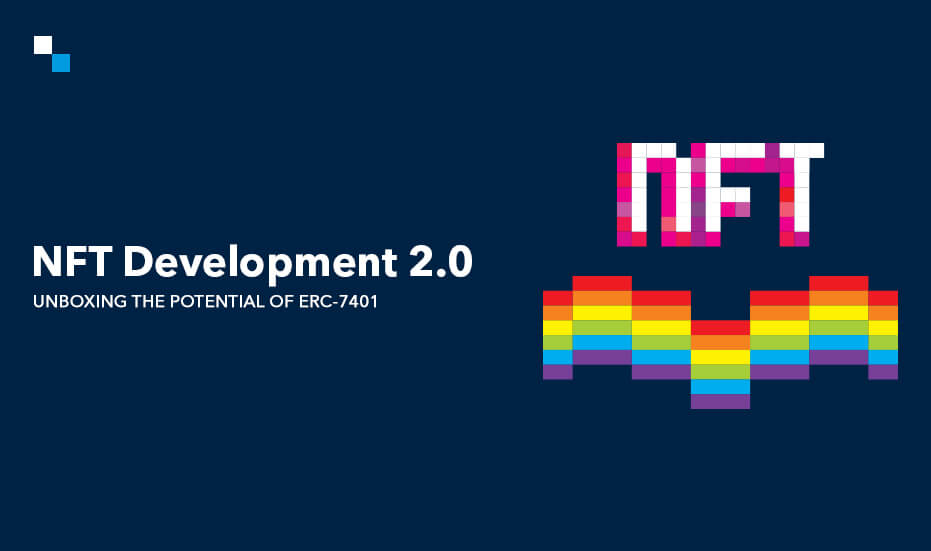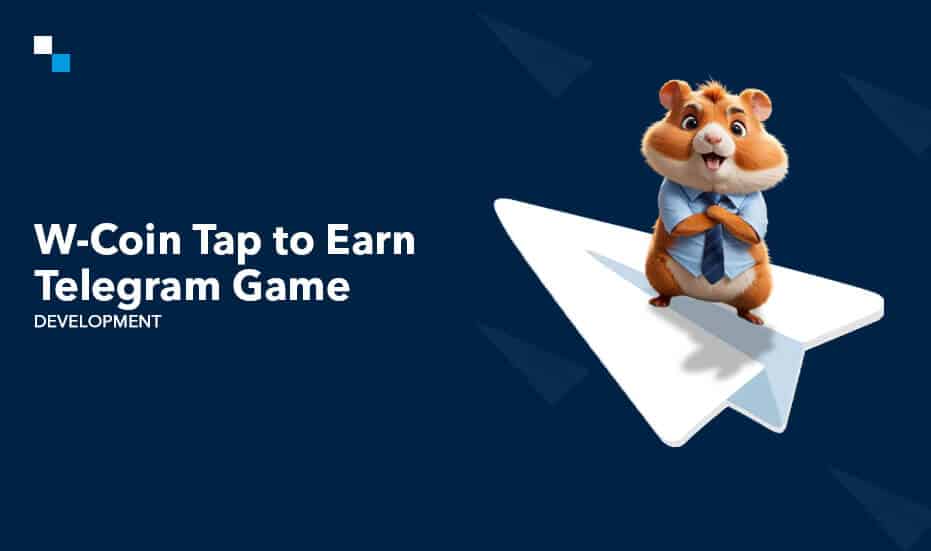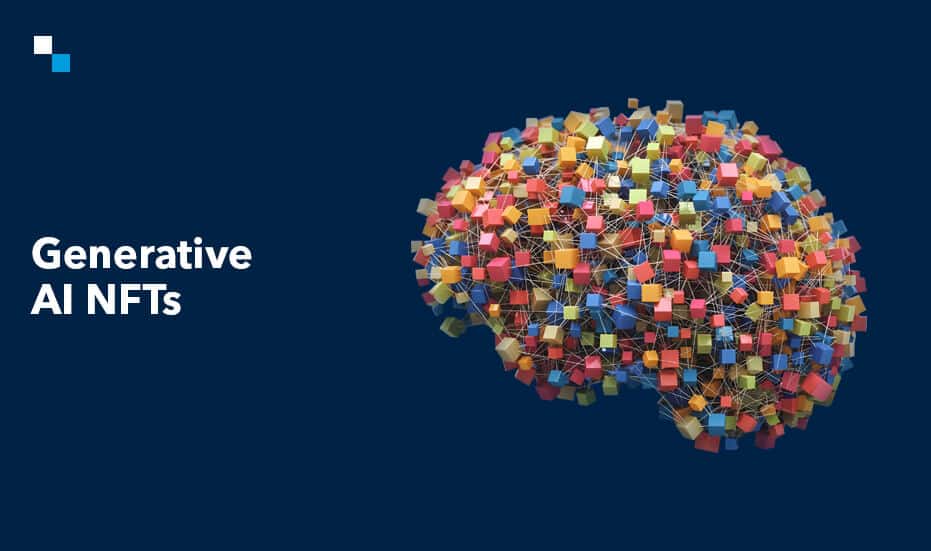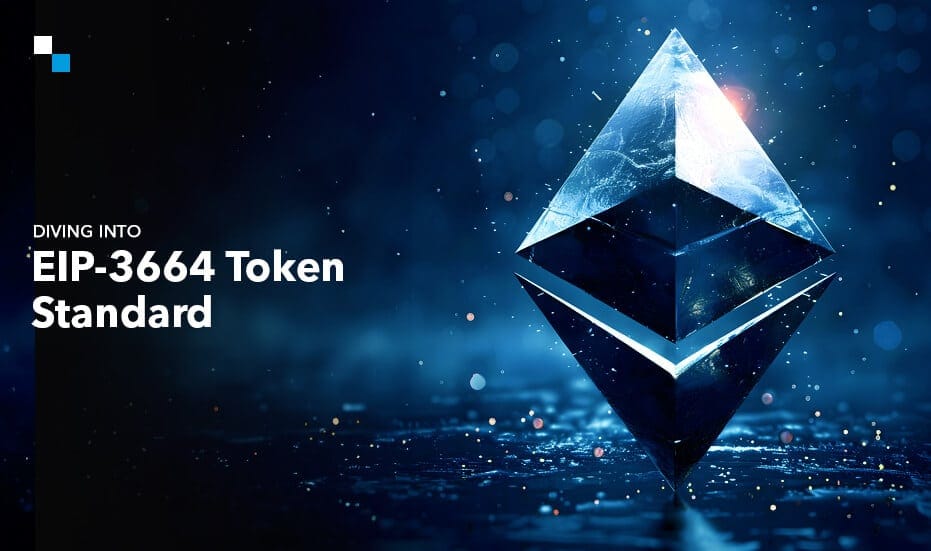
Web3 – The Secret Weapon for a Secure and Streamlined Supply Chain
April 12, 2024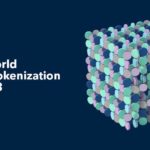
Tokenized Reality: Real World Asset Tokenization in Web3
April 12, 2024Table of Contents
Introduction
The world of NFTs is evolving. We’ve all heard of owning a single digital asset as an NFT, but what if you could hold an entire collection within one NFT? That’s the exciting potential of NFT development on the ERC-7401 standard. This innovative approach allows creators to build complex NFT structures with nested functionalities. Known as “NFT 2.0”, ERC7401 pioneers nesting multiple child NFTs within a parent token. This facilitates managing lost or inaccessible funds through a standardized recovery process.
A NFT development company and artists are embracing this new frontier, unlocking a wave of possibilities for collectors and gamers alike. If you’re curious about how ERC-7401 NFT development services development can transform your NFT project, keep reading. We’ll delve into everything you need to know about this groundbreaking standard.
Nested NFT Development: Exploring ERC-7401 Standard
ERC-7401, also called Parent-Governed Nestable Non-Fungible Tokens, was proposed in late 2022 as a novel approach to structuring NFT ownership. It allows one NFT to possess others, creating a nested hierarchy where a “parent” NFT contains multiple “child” tokens. Child tokens can also function as parents for the additional NFT development.
Significant analysis and community feedback led to revisions of the initial ERC-6059 standard proposal. Now formalized as ERC-7401, it may be adopted by the NFT development company for effective management of interrelated groups of NFTs together via nesting capabilities.
However, let’s first grasp the whole concept of ERC 7401 and its highlights:
- Parent Power: This is the core of ERC-7401 – a single “parent” NFT can hold multiple “child” NFTs within it, utilizing NFT development services. These child NFTs can represent various things, depending on the creator’s vision.
- The Nesting Chain: A child NFT can itself become a parent, holding its own collection of NFTs. This creates a hierarchy or “nesting” structure, allowing for complex and interconnected NFT development.
- Parental Authority: The owner of the parent NFT has complete control over all the child NFTs they hold. A NFT development company can leverage this feature to create unique governance models within NFT collections.
- Nesting: Adding a child NFT to a parent NFT is a special transaction within the ERC-7401 framework. This ensures secure and controlled nesting.
- Unnesting: Similarly, separating a child NFT from its parent requires a specific transaction with the parent owner’s approval. This child NFT can then be sent to another wallet, become a parent itself, or even be “unnested” and exist independently with NFT development services.
- Openness and Flexibility: Unlike some other nesting standards, ERC-7401 allows parent and child NFTs to belong to different collections. As long as both collections adhere to the ERC-7401 standard, they can be nested together. ERC-7401 can be used for more engaging and functional NFT development, potentially increasing their value and collectability.
A Word on Existing NFTs:
It’s important to note that regular ERC-721 NFTs (the current standard) cannot be directly nested with ERC-7401 collections. This means popular existing NFTs like Azuki or Pudgy Penguins can’t be integrated into an ERC-7401 nesting structure. However, with the growing popularity of ERC-7401, future NFT projects are likely to be built on this standard by the NFT development company.
ERC721 Vs ERC7401 for NFT Development Services
Both standards serve different needs for NFT development services. ERC721 remains flexible while ERC7401 enhances structured metadata, ownership models, and interoperability for robust networks.
ERC721: The OG of NFTs
Flexibility is a major strength of ERC721, allowing NFT development for a wide variety of digital assets – from artwork and collectibles to in-game items and even virtual real estate. ERC721 is well-established and widely used, making it a familiar choice.
ERC7401: Building on Top
ERC7401 introduces the concept of “nested” NFTs. This opens doors for complex ownership structures and exciting new use cases.
Key Differences:
Here’s a quick breakdown of the key differences between ERC721 and ERC7401:
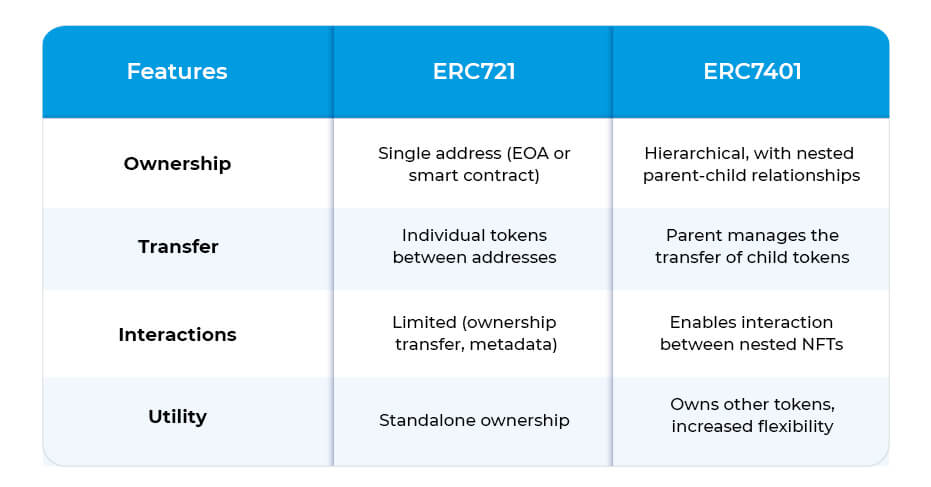
Choosing the Right Standard for Your Needs
ERC721 remains a strong choice for basic NFT projects due to its flexibility and established nature. However, an experienced NFT Development Company can determine the optimal standard based on project specifications.
ERC-7401- Detailed Benefits for NFT Development
ERC-7401 provides the standardized framework leveraging advanced functionalities for innovative NFT development services.
It presents many benefits, such as;
- Enhanced Security
Implementing ERC-7401’s structured metadata approach for NFT development secures transactions and interactions, closing doors for cyber threats. - Increased Interoperability
It facilitates efficient information and asset exchanges, through standardized data formats improving interoperability. - Improved Scalability
Its defined guidelines lay the groundwork for blockchain networks to handle greater transaction volumes at higher speeds. - Standardization
Adhering to ERC-7401’s standards the NFT development company can ensure compatibility and consistency of developed NFTs across platforms. - Advanced Functionalities
Features like nested tokens enable new use cases for hierarchical ownership models, complex NFT relationships, bundled products, and membership implementations. This expands the scope of NFT development services.

NFT Creation on ERC-7401 with NFT Development Company
ERC-7401, an innovative standard enables complex creations like in-game item collections within a character NFT, or tiered memberships with exclusive content hidden inside.
A professional NFT development team can guide you through every step of building your groundbreaking ERC-7401 project.
While a basic understanding of blockchain is helpful, a deep dive into ERC-7401’s functionalities is essential. Familiarize yourself with concepts like nested ownership, parent-child relationships, and token interactions. Partnering with an experienced NFT development company can translate this exciting concept into a reality for you.
NFT development services include:
- Smart Contract Design: A secure and efficient contract creation governs the nesting functionalities and interactions within your NFTs.
- Custom Functionality: Want to add unique features to your nested NFTs? The right development team can integrate features like tiered access controls or dynamic content updates within the parent NFT.
- Seamless User Experience: NFT development by experts ensures your project has a smooth and intuitive experience for collectors and users.
ERC-7401 NFT Development: Applications Across Industries
ERC-7401’s Nestable tokens can be used for diverse applications across sectors with an NFT development company. Some examples are:
- Revolutionizing Communities
Additional privileges/NFTs can be issued within membership tokens to enhance engagement for community platforms. Access NFT development services to create nested NFTs containing access tokens or loyalty points within membership NFTs. Imagine an NFT for a fan club, holding exclusive content for each season nested within it. - Boosting Supply Chain Transparency
With ERC-7401, each shipped item can be an NFT. These individual NFTs can then be bundled together into a parent NFT representing the entire shipment. As items are delivered, their child NFTs can be separated, simplifying tracking within complex supply chains. - Supercharging Soulbound NFTs (SBTs)
SBTs are unique tokens tied to a specific wallet address. ERC-7401 takes them a step further. A SBT can represent your educational background. With ERC-7401, you can “upgrade” this SBT with nested NFT development, like proof-of-attendance tokens for each completed course. This creates a verifiable and detailed record of your achievements. - Streamlining Bundling and Collecting
ERC-7401 makes selling your entire NFT collection as a single unit possible. Users can bundle multiple NFTs together into a single-parent NFT. - Empowering DAOs and Memberships
Membership NFTs can be structured to hold benefits like loyalty points within them, simplifying distribution and management for organizations (like DAOs). Additionally, the ability to delegate ownership or voting rights to other NFTs within the structure facilitates a more efficient and flexible governance process. - Enhancing In-game Experiences
NFT development company can use ERC-7401 to create a more dynamic in-game experience. Imagine a character NFT holding nested NFTs for all your weapons and armor for innovative gameplay mechanics like crafting items by combining nested components. - Unifying Multimedia Content
Content creators can now bundle various multimedia assets – images, videos, and music – into a single-parent NFT through NFT development services. A NFT for a music album can also includes behind-the-scenes footage and exclusive artwork, nested within the main song file.
Conclusion
ERC-7401 heralds the commencement of a revolutionary phase for NFTs, enabling nesting capabilities and hierarchical management of digital assets. Only recently finalized in September 2023, its future adoption is yet to be seen but brings improved functionality. As ERC-7401 NFT development explores its capabilities, we can expect to see even more innovative use cases emerge, across diverse industries.
Antier, an experienced NFT Development Company has been at the forefront of innovations, with a deep understanding of standards like ERC-721, 1155, and now 7401. With expertise in translating visions into reality, we offer dedicated NFT Development services customized for each project’s needs. Connect with our professional developers to witness how we drive the frontier of this energetic industry across spheres. Stay tuned for what’s next!
